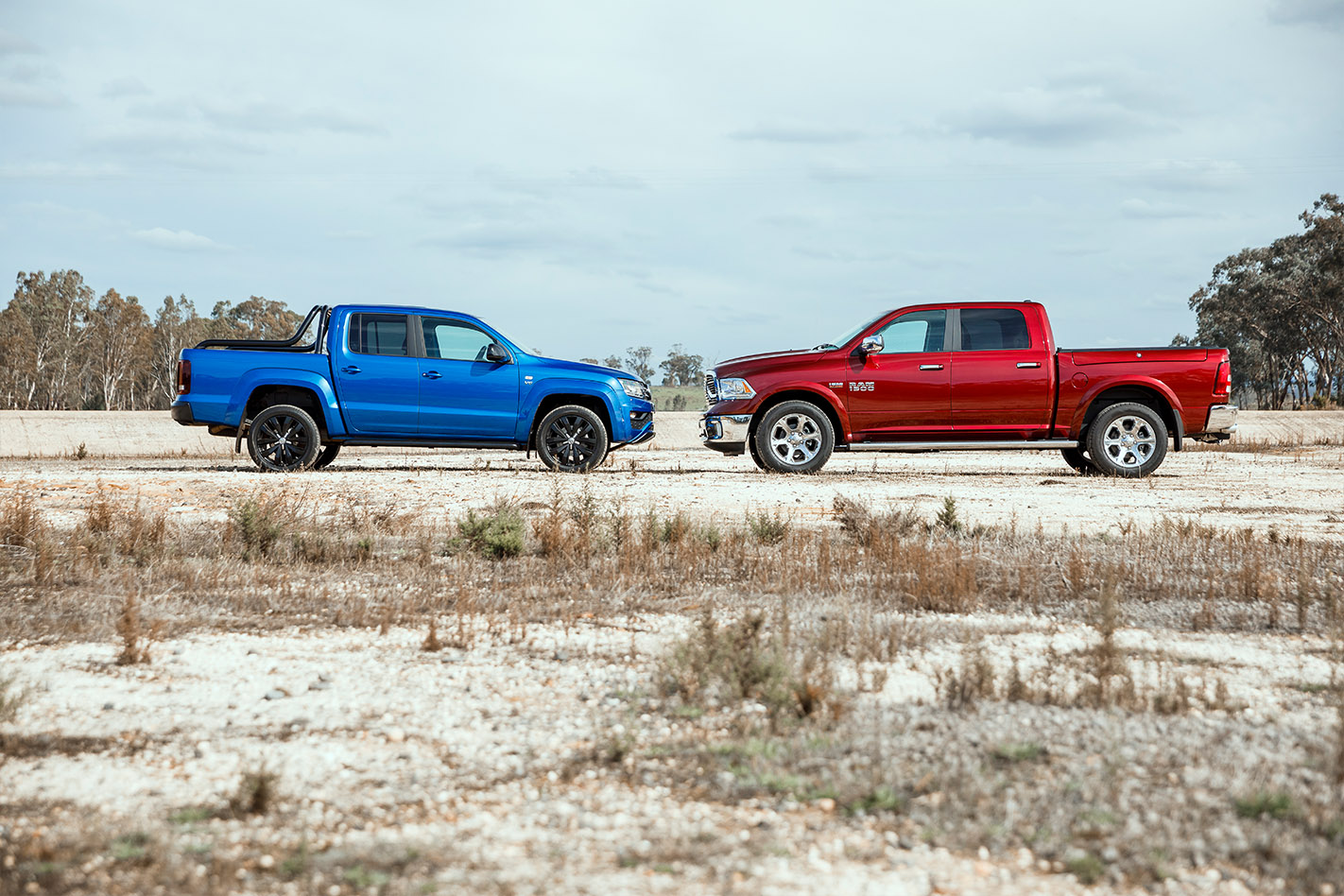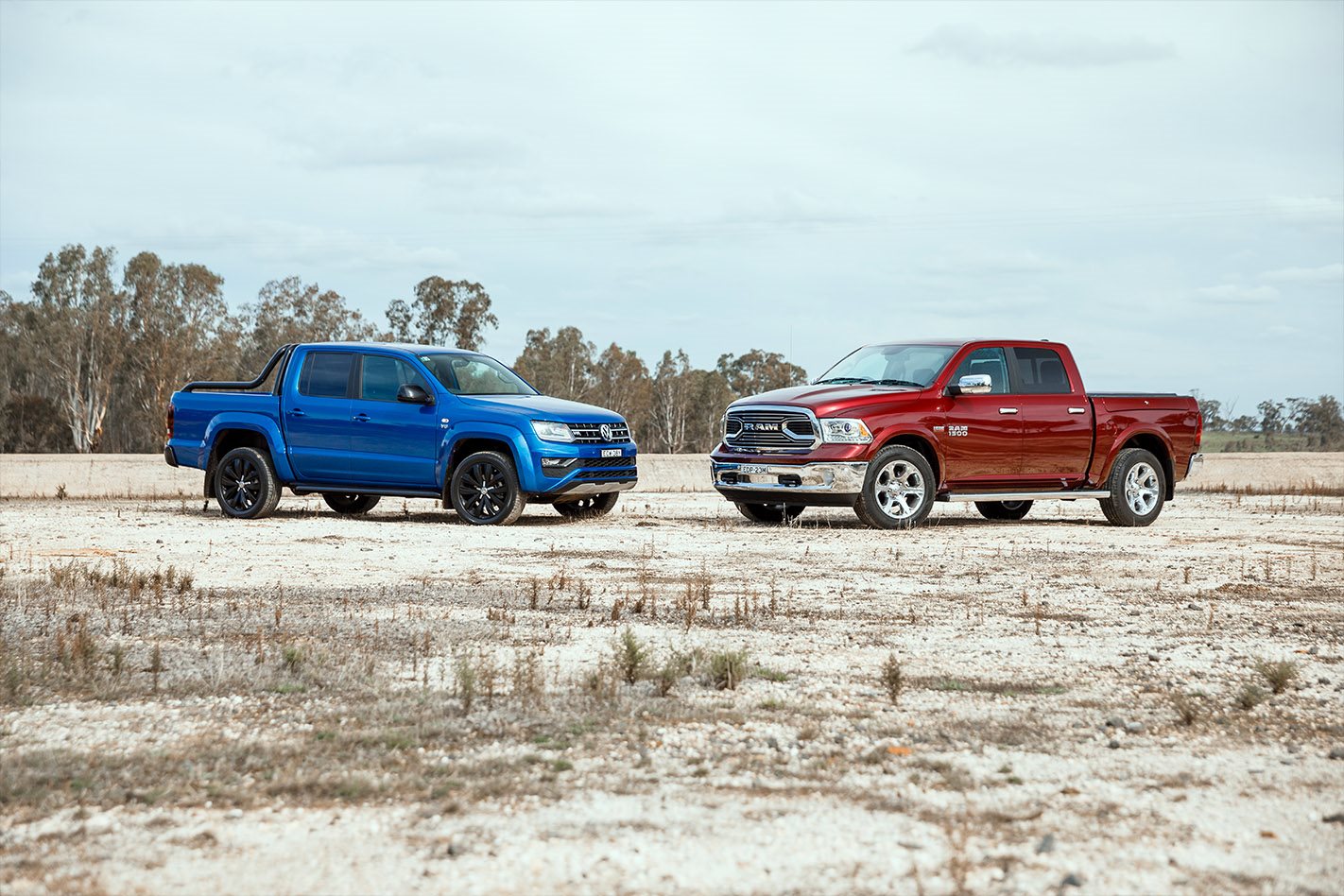This is a mismatch.
That much became apparent when we parked these two vehicles next to one another.
What we’re here to discover today is just how much of a mismatch pitting the Volkswagen Amarok Ultimate 580 against the Ram 1500 Laramie proves to be.
TALE OF THE TAPE
In the blue corner we have the current dual-cab champ, the Amarok. Priced at $72,790 and powered by a 3.0-litre V6 turbo-diesel that cranks out 190kW/580Nm, the Volkswagen has aced everything we’ve thrown at it in this division. With that in mind, we decided to see how it fared if we took it out of its comfort zone.
Towering over it from the red corner is the $99,950 Ram 1500 Laramie. ‘Re-engineered’ to right-hand drive at Walkinshaw’s plant in Clayton, the monster Yank pick-up features a 5.7-litre V8 Hemi petrol powerplant good for 291kW and 556Nm. So it’s an advantage in power to the Ram and an early points victory for the Volkswagen on torque, arguably a more important metric for ute buyers.
Factor in torque-to-weight and the European dual-cab extends its head start. Where the Ram develops 210Nm per tonne, the Volkswagen puts clear air between the two vehicles with a monster 264Nm per tonne.
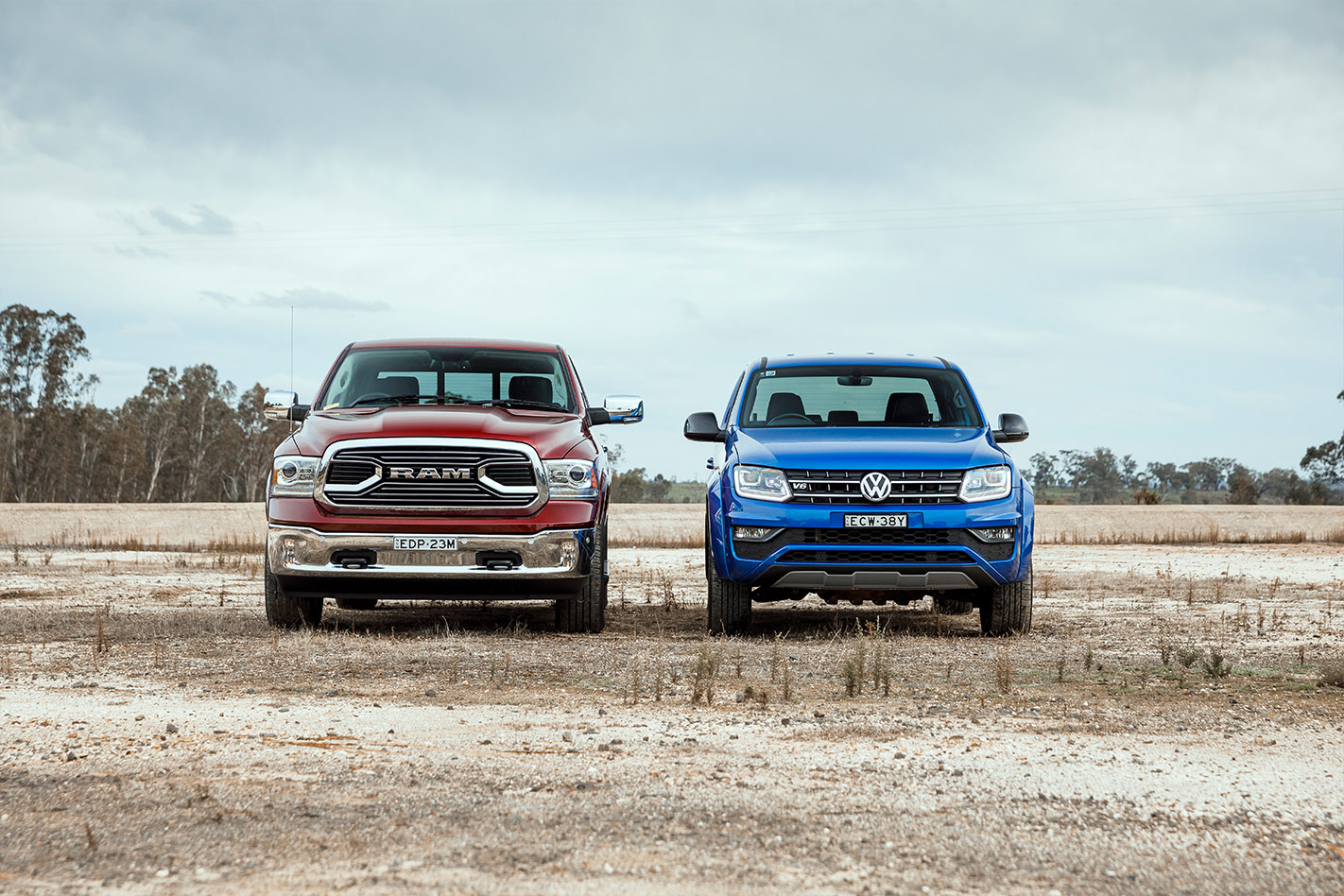
WHICH IS QUICKER?
Full disclosure is probably due here. We’d booked the Ram to put up against its Clayton stablemate, the new Chevrolet Silverado 1500 V8, but in order to provide a little perspective, we figured we’d bring the Amarok along. So, with that in mind, we find ourselves at Heathcote Raceway 130km north of Melbourne with the slightly surreal proposition of eking performance figures out of these monsters.
The Amarok first. With its torque-to-weight advantage, smaller frontal area and far more focused tyres, the Volkswagen looks up for the fight. In fact, the wheel and tyre set look as if they’ve come off a city slicker Touareg rather than anything that’s ever going to bump across a building site.
Winding the gutsy diesel engine up against its torque converter and sidestepping the brake gives a crisp step off the line and the surge of turbocharged grunt seems relentless. Volkswagen claims a 100km/h sprint of just 7.3 seconds, but the best we could squeeze out of the Amarok after several attempts was a rather disappointing 7.7 seconds.
Beyond 100km/h the intervals between gearchanges stretches out and 400m comes and goes in 15.6 seconds at 143.8km/h. The fence at the end of Heathcote’s strip then becomes a more pressing concern, the VW ultimately recording 170km/h in 26.5 seconds.
Now it’s time to see whether the Ram can make a few arguments why you should pay an extra $27K for the privilege. It gets off the line even more sharply than the Volkswagen, the big V8 earning its corn. By 100km/h, it has carved almost a second out of the Amarok, recording 6.8 seconds. It roars through 400m in 14.8 seconds at 148.5km/h, tripping the VBOX’s 170km/h increment in 21 seconds flat.
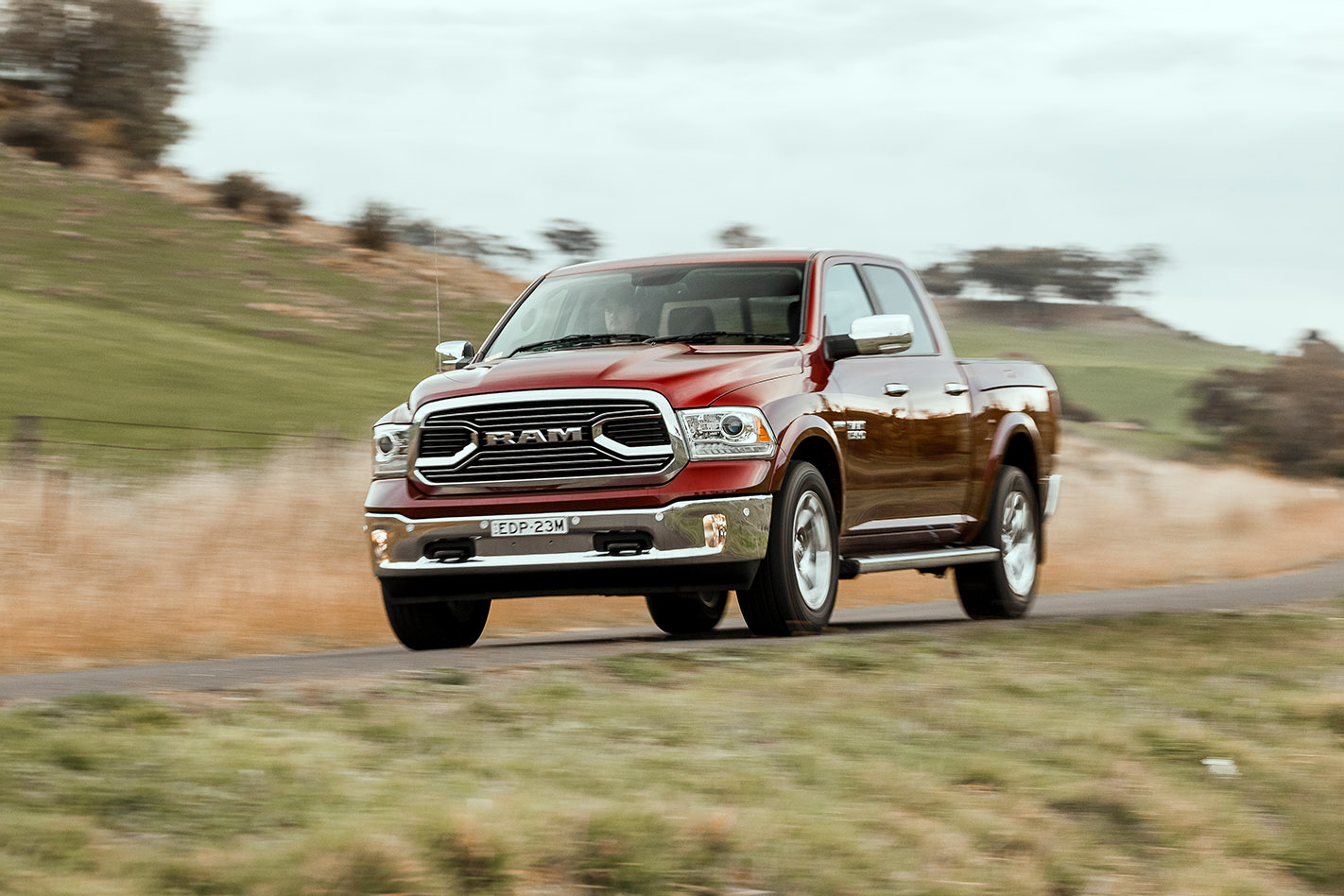
WHAT ABOUT TOWING?
Now, we’ll agree that drag figures for big utes probably isn’t the most relevant metric to base your purchasing decision on. You’ll probably be more concerned about the fact that the Ram 1500 can tow 4.5 tonnes (braked) where the Amarok 580 can haul 3.5 tonnes.
Also consider that Volkswagen recommends a maximum speed of 80km/h if you’re towing over 3300kg. That would make cross-country journeys drag a little. There is no speed limitation recommended for the Laramie. It’s also worth bearing in mind that the Amarok’s maximum towball download is 300kg, compared with the Laramie’s 350kg.
Most Aussie trailers weigh more than 3000kg and the recommended towball download is 10 per cent of trailer mass.
Then there’s an issue common to most dual-cab utes in this sector. They can’t carry any significant payload and tow to their maximum capacity. Volkswagen quotes a payload of 836kg for the Amarok 580 and its kerb weight of 2196kg means that if you’re towing a 3500kg trailer, you’ve only got 304kg of payload to play with before you run into the 6000kg Gross Combination Mass (GCM).
If you’re at all acquainted with the Colonel’s value menu, that’s 100kg or so accounted for just there. See where I’m going with this?
That’s why there is a market for something bigger than the current dual-cabs. Read the small print, however, and the Ram also butts up against a GCM ceiling.
The Laramie’s 800kg payload maximum looks adequate, but to not exceed GCM when towing its advertised 4500kg, your available payload is a piffling 87kg. So it’s likely the vehicle would be overweight once you’d climbed aboard.
Drop the trailer weight to 3500kg and you have a 450kg payload, up 146kg on the Volkswagen. Another point to note is that the Ram 1500 Laramie is also offered with a taller 3.21:1 diff ratio that helps save fuel but exacerbates the GCM issue.
In other words, take that 4.5-tonne tow rating with a shovelful of salt.

HOW DO THEY DRIVE ON THE ROAD?
Prior to this test, we’d expected that the Amarok would shame its US counterpart in terms of interior finish and sophistication, but that’s not exactly the case. It’s a fact that most of the interior architecture is – quite understandably – similar to the $45K Amarok TDI 400 Core, with the same hard dash plastics and cabin architecture and controls that are redolent of a budget late-Noughties Golf.
That’s hardly surprising, as this generation Amarok is nine years old now. While it’s good for its class, it’s still not what you’d expect in terms of equipment and fit and finish of a modern compact SUV.
What’s more, a compact SUV seems about the right form factor by which to measure the rear-seat accommodation in the Amarok. Its 3095mm wheelbase is longer than that of a Mercedes-Benz S-Class, but in order to house a 1570mm-long rear tray, some cuts have had to come from somewhere, and that somewhere appears to be rear-seat legroom. It’s a little snug back there.
The Ram, by contrast, feels airy in the back. The rear seat can flip up and a flat temporary floor extends so that you can stack boxes or anything that you don’t want in the bed. The bed itself is 1737mm long and 1270mm wide. That compares with the Amarok V6’s 1600mm maximum width.
Why so narrow? That’s because this Ram is fitted with the optional $4500 RamBoxes. These boxes sit on either side of the bed, above the wheelarch tubs. Remotely lockable, they feature internal lighting and can be internally drained, so that you can throw a load of ice in there and use them as drinks coolers if you like.
That price also includes a cargo bed divider, cargo bed rails with tie-down cleats, cargo bed lighting and a tonneau cover. Between the arches, the Amarok’s bed measures 1220mm, so there’s only 50mm difference between the two vehicles.
Driving the two is chalk and cheese. The Ram initially feels huge, with the high bonnet stretching ahead of you, but its coil-sprung rear end helps it sit well on the road and, for such a big, bluff truck, wind noise is surprisingly modest.
The steering lacks a bit of reassurance around the straight ahead, but the chunky treadblocks and hefty sidewalls of the 275/60 R20 Hankook Dynapro HT off-road rubber probably accounts for much of that initial vagueness. In short, you’ve got 165mm of sidewall height versus 127.5mm on the Amarok, or an extra 29 percent if you prefer.
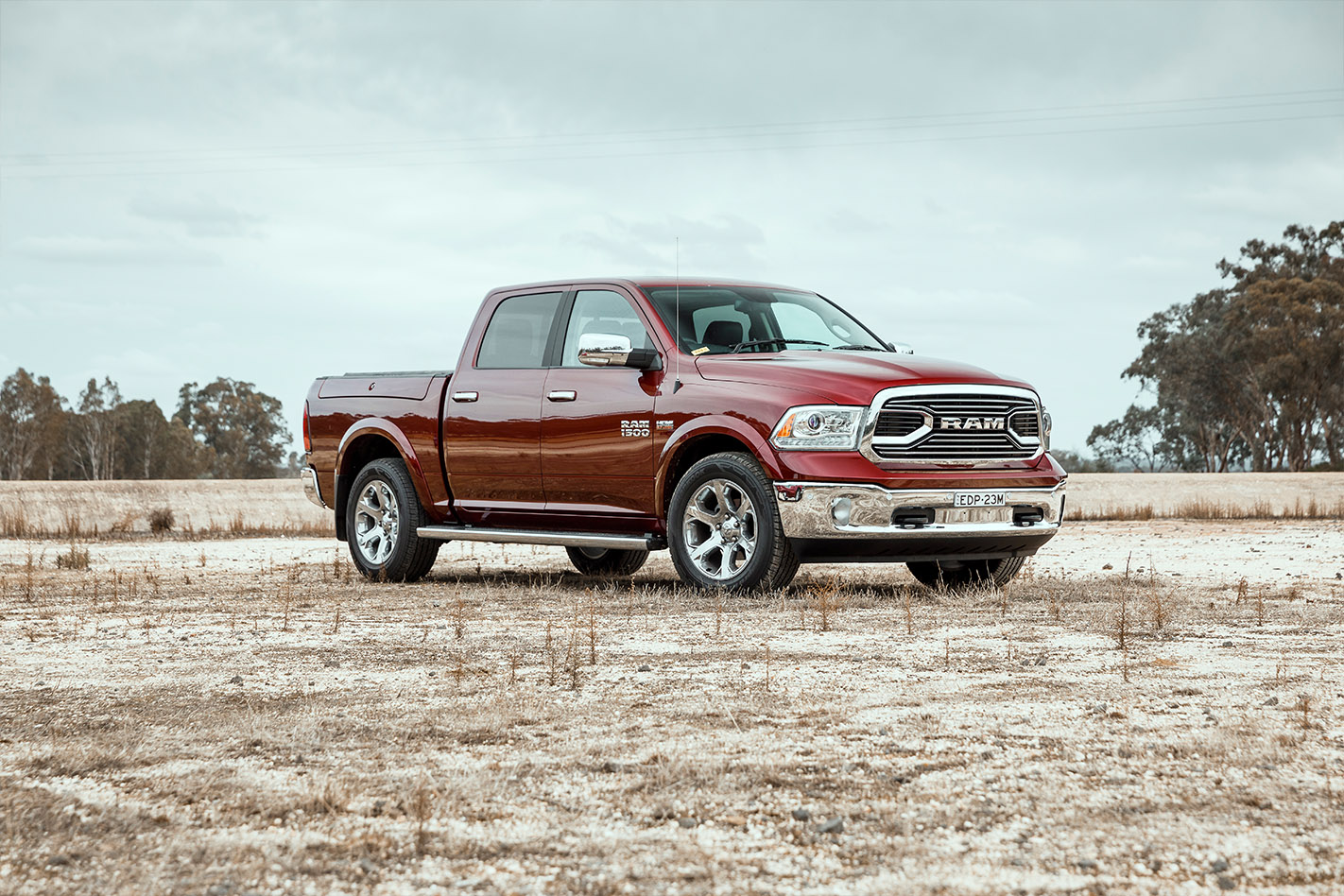
What is surprising is how little headroom you have behind the wheel. The sunroof eats into the available space and you sit very high on the electrically adjustable chairs, so forget about wearing a celebratory Stetson.
The right-hand drive conversion work is well executed, but there’s that typically American blindspot when it comes to quality of finish, with hard plastics, chintzy chrome and woodgrain, a foot-operated handbrake and ergonomically tone-deaf features like the vestigial centre rear seat or the rotary lighting controller that you collect with your right knee when you climb into the cabin.
Compared to the Ram, the Amarok’s cabin feels very well considered, if a good deal less well equipped.
The Ram’s Alpine stereo is punchy and the infotainment system offers easy smartphone mirroring (both vehicles are fitted with Android Auto and Apple CarPlay as standard). The heated and vented front seats are partnered with heated rear seats and a heated steering wheel.
After the Ram’s excesses, the Amarok’s manually adjustable seats, manual handbrake, no tub liner, lack of sunroof and a host of switch blanks feels a bit mean for a $73K vehicle that wears an Ultimate badge.
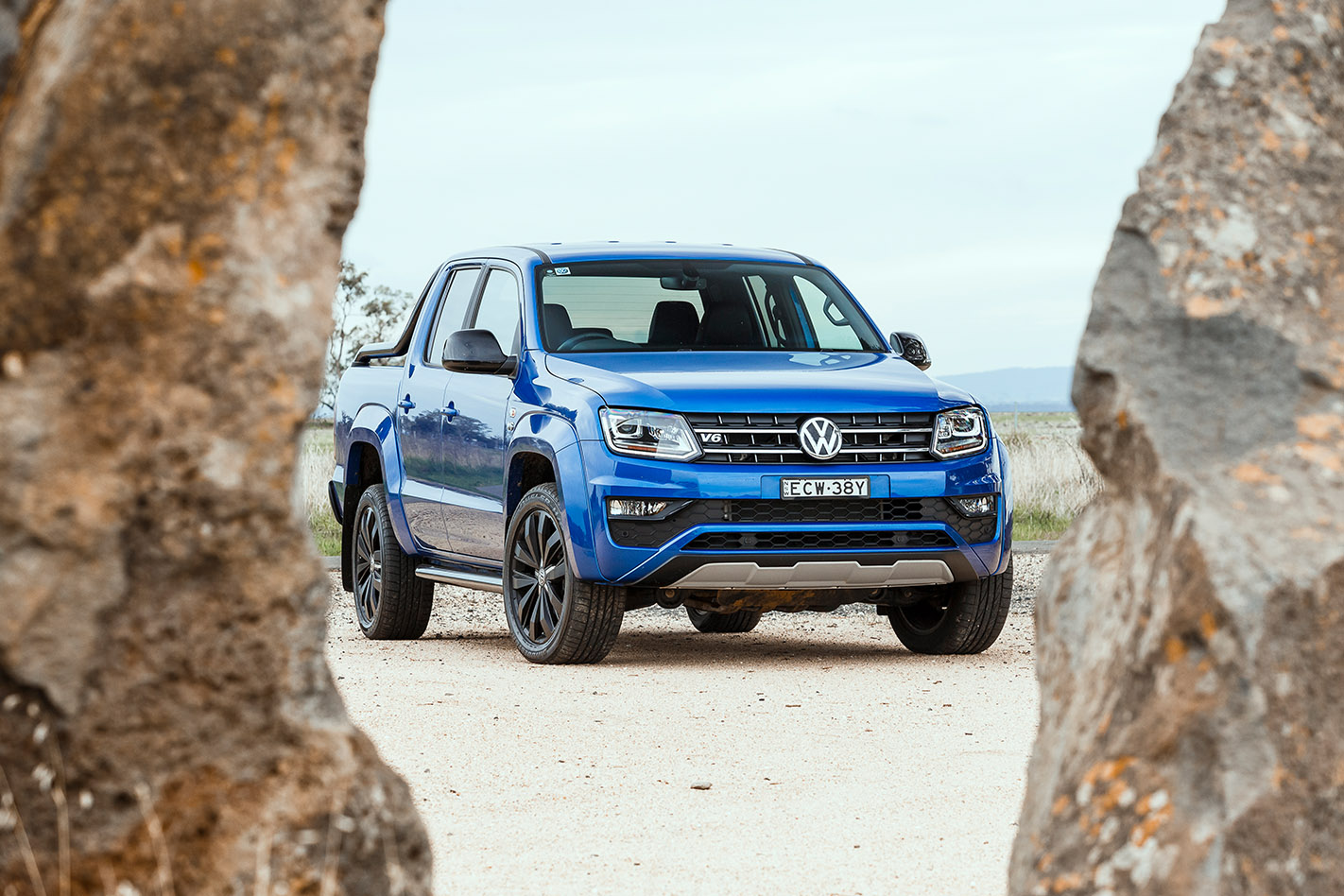
VERDICT
So what do we learn by putting the top Amarok against this powerhouse Ram? The biggest take-away is to be very careful what you ask for. The Ram’s billed 4.5-tonne towing capability is a bit of a misnomer, and if you’re towing 3.5 tonnes, the difference in available payload between the two vehicles is surprisingly small.
What’s more, the Amarok is a more pleasant thing to pilot about for most of the time. Like all unladen utes, it’s a bit skippy on a poor road, but even with that provocation, its front end tracks very true. It feels manageably sized and therefore able to negotiate multistorey or underground car parks without a great deal of pre-planning.
Its fuel economy on our test day was 9.8L/100km. The Ram drank 14.5L/100km. Yes, fuel is cheap right now while Russia and Saudi Arabia are swinging handbags at each other, but that’s not always going to be the case.
Then there’s the fact that the Amarok braked from 100km/h in 37.5 metres, whereas the best figure we could get from the Ram was 40.2 metres. Consider which one you’d want to be in if towing something downhill on a wet road.
This was a mismatch. It was always going to be the case. The Ram is so much bigger and more overt than the Amarok, but the longer we spent with the two vehicles, the more we appreciated why the Volkswagen has come to define the dual-cab class. It’s just a very strong package. It doesn’t have anything like the charisma of the Ram 1500 nor its equipment levels but it’s quick enough and brawny enough to cover most bases.
Is the Ram $27K better? Some will see the value there. The unburstable Hemi V8 is full of character and there’s something big-hearted and earnest, if endearingly clumsy, about the Laramie’s execution that’s hard not to like. That just about gets it a close points decision. We expected to see the Amarok flattened at the opening bell. That it wasn’t sparked out is, in its own way, some sort of win.
We try to steer away from ‘horses for courses’ verdicts here at Wheels. They’re usually the sign of a badly conceived comparison. In this instance, both vehicles emerge with their reputations burnished, and if you’re looking for a more definitive decision, look out for Silverado 1500 versus Ram 1500 showdown coming soon.
Sign-up here to get the weekly Wheels highlights
